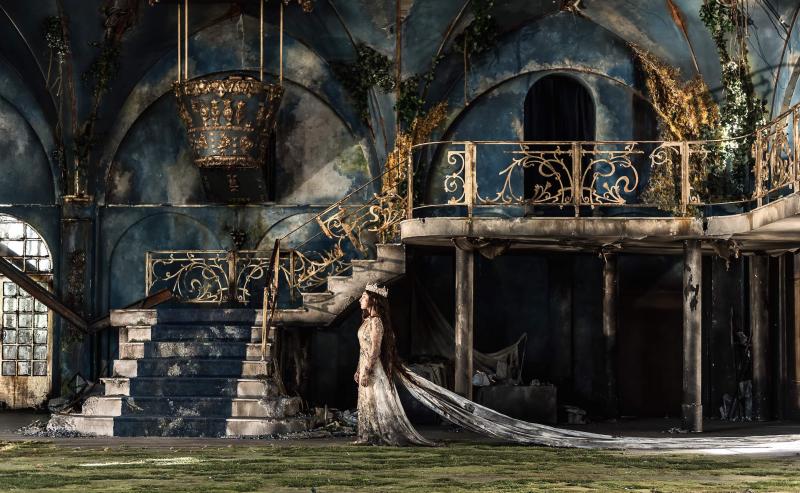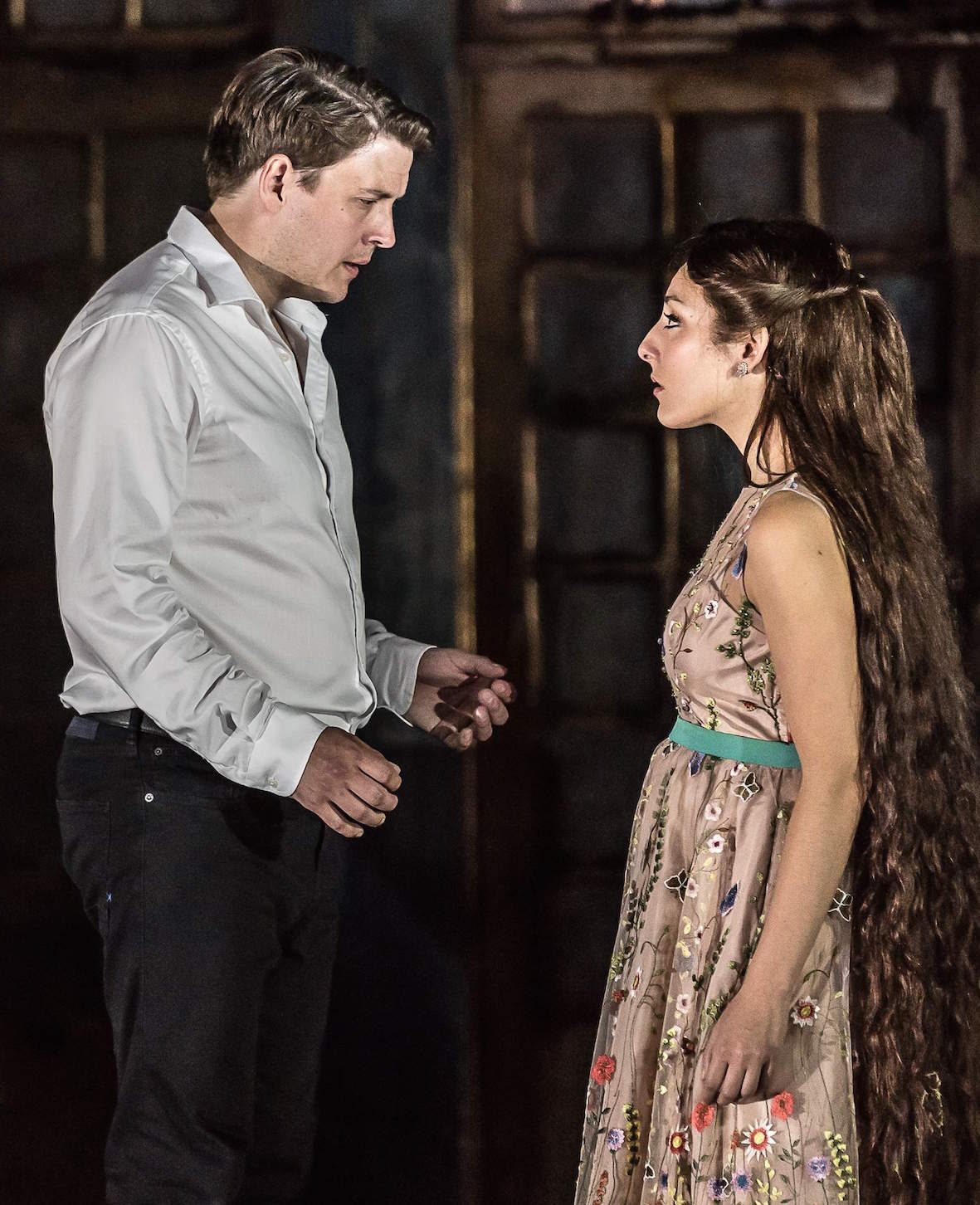Pelléas et Mélisande, Garsington Opera review - brilliant but frustrating | reviews, news & interviews
Pelléas et Mélisande, Garsington Opera review - brilliant but frustrating
Pelléas et Mélisande, Garsington Opera review - brilliant but frustrating
Masterpiece of communication failure beautifully played and designed but impassively staged

A drama of passion for essentially passive characters, Debussy’s one and only completed opera is a masterpiece of paradox. How do you stage a work whose dramatis personae hardly seem aware of their own destructive feelings, and who inhabit their island world like the blind who, according to Pelléas, used to visit the curative fountain but stopped doing so when the king himself went blind?
Michael Boyd, in his beautiful but occasionally frustrating production for Garsington Opera, approaches - if he doesn’t wholly solve – this problem by treating each of the 15 scenes as a kind of static tableau in which the characters often seem incapable of approaching or even looking at each other. “Don’t touch me” are Mélisande’s first words to Golaud, and still in the penultimate scene the adoring Pelléas admits, “I have not yet dared look her in the eye.”
At the same time Boyd cleverly animates the drama by linking the rat-tat-tat of short scenes with action not envisaged by either the composer or the author of the original play, Maurice Maeterlinck, but necessitated by the lengthy interludes Debussy extended at short notice to cover the scene changes. Golaud’s son Yniold appears first in Act 3 of the score, but is here present from the start, on Golaud’s or Mélisande’s arm, playing ball with the moon, and even rescuing Mélisande’s crown from the well into which we have, no less uncanonically, watched her drop it during the prelude.
 No scene changes here. Everything takes place in a single fixed set (designer Tom Piper, lighting by Malcolm Rippeth) that resembles nothing so much as the grand salon of a sunken liner, all blue and gold, with staircases right, left and centre, an apparently floating balcony, various dark corners, and a general air of submarine decay. Whatever else one might say about the performance, it’s stunningly watchable. Boyd’s dramaturgy is like a film: for instance, entering the dungeon Golaud and Pelléas descend a rickety staircase from high on the left, but later re-emerge at stage level centre, implying a shifting space far larger than the visible frame. The forest becomes the castle hall, the castle becomes the cave. The whole of Allemonde – an island nowhere – is crammed into this moribund salon of misunderstood and barely even recognised emotion.
No scene changes here. Everything takes place in a single fixed set (designer Tom Piper, lighting by Malcolm Rippeth) that resembles nothing so much as the grand salon of a sunken liner, all blue and gold, with staircases right, left and centre, an apparently floating balcony, various dark corners, and a general air of submarine decay. Whatever else one might say about the performance, it’s stunningly watchable. Boyd’s dramaturgy is like a film: for instance, entering the dungeon Golaud and Pelléas descend a rickety staircase from high on the left, but later re-emerge at stage level centre, implying a shifting space far larger than the visible frame. The forest becomes the castle hall, the castle becomes the cave. The whole of Allemonde – an island nowhere – is crammed into this moribund salon of misunderstood and barely even recognised emotion.
But while Boyd’s characters freeze or stand helpless, the Philharmonia Orchestra under Jac van Steen leave us in no doubt about the brooding, sometimes raging passions they’re unable to express. This is a brilliant, uninhibited reading of Debussy’s not entirely restrained score. While Golaud gives a few cursory tugs at Mélisande’s hair after catching her in flagrante delictu with Pelléas on the balcony, the orchestra swirls and heaves his repressed violence; and while the lovers declare their passion at 20 paces in the penultimate scene, van Steen and co. itemise their true desires. The playing throughout is superb.
Like Wagner, Debussy reveals almost everything in the orchestra. But the singers also need attention, and though van Steen coordinates this rich and complex music – stage and pit – without a hitch, there are times when one would like to hear a little more of the voices. Only Paul Gay’s perhaps too aged Golaud (he has, after all the same mother as the youthful Pelléas), and Brian Bannatyne-Scott’s Arkel ride the orchestra dependably. William Davies does his overtime as Yniold with an expertise beyond his years, but often comes off second best in terms of balance. Susan Bickley is a warm, comforting Geneviève, also more in evidence than the score implies, and none the worse for that.
At the focus of it all, Andrea Carroll and Jonathan McGovern (pictured above) look and sound well enough, but suffer somewhat from the restraint imposed on them by the production. Carroll, a dark-haired, mezzoish Mélisande, is good at the poised and mysterious but lacks consistent intensity. McGovern, a high baritone Pelléas in plain shirt and trousers (he has sung Papageno and Purcell’s Aeneas, but also Monteverdi’s Orfeo) likewise sings with great polish but never quite convinces that love is a case of kill or be killed.
Any Pelléas as beautiful and musically accomplished as this will intrigue and fascinate like few other operas. To judge by the audience response, I may be almost alone in also wanting a shade more electricity in the lack of communication.
more Opera
 Simon Boccanegra, Hallé, Elder, Bridgewater Hall, Manchester review - thrilling, magnificent exploration
Verdi’s original version of the opera brought to exciting life
Simon Boccanegra, Hallé, Elder, Bridgewater Hall, Manchester review - thrilling, magnificent exploration
Verdi’s original version of the opera brought to exciting life
 Aci by the River, London Handel Festival, Trinity Buoy Wharf Lighthouse review - myths for the #MeToo age
Star singers shine in a Handel rarity
Aci by the River, London Handel Festival, Trinity Buoy Wharf Lighthouse review - myths for the #MeToo age
Star singers shine in a Handel rarity
 Carmen, Royal Opera review - strong women, no sexual chemistry and little stage focus
Damiano Michieletto's new production of Bizet’s masterpiece is surprisingly invertebrate
Carmen, Royal Opera review - strong women, no sexual chemistry and little stage focus
Damiano Michieletto's new production of Bizet’s masterpiece is surprisingly invertebrate
 La scala di seta, RNCM review - going heavy on the absinthe?
Rossini’s one-acter helps young performers find their talents to amuse
La scala di seta, RNCM review - going heavy on the absinthe?
Rossini’s one-acter helps young performers find their talents to amuse
 Death In Venice, Welsh National Opera review - breathtaking Britten
Sublime Olivia Fuchs production of a great operatic swansong
Death In Venice, Welsh National Opera review - breathtaking Britten
Sublime Olivia Fuchs production of a great operatic swansong
 Salome, Irish National Opera review - imaginatively charted journey to the abyss
Sinéad Campbell Wallace's corrupted princess stuns in Bruno Ravella's production
Salome, Irish National Opera review - imaginatively charted journey to the abyss
Sinéad Campbell Wallace's corrupted princess stuns in Bruno Ravella's production
 Jenůfa, English National Opera review - searing new cast in precise revival
Jennifer Davis and Susan Bullock pull out all the stops in Janáček's moving masterpiece
Jenůfa, English National Opera review - searing new cast in precise revival
Jennifer Davis and Susan Bullock pull out all the stops in Janáček's moving masterpiece
 theartsdesk in Strasbourg: crossing the frontiers
'Lohengrin' marks a remarkable singer's arrival on Planet Wagner
theartsdesk in Strasbourg: crossing the frontiers
'Lohengrin' marks a remarkable singer's arrival on Planet Wagner
 Giant, Linbury Theatre review - a vision fully realised
Sarah Angliss serves a haunting meditation on the strange meeting of giant and surgeon
Giant, Linbury Theatre review - a vision fully realised
Sarah Angliss serves a haunting meditation on the strange meeting of giant and surgeon
 Der fliegende Holländer, Royal Opera review - compellingly lucid with an austere visual beauty
Bryn Terfel's Dutchman is a subtly vampiric figure in this otherworldly interpretation
Der fliegende Holländer, Royal Opera review - compellingly lucid with an austere visual beauty
Bryn Terfel's Dutchman is a subtly vampiric figure in this otherworldly interpretation
 The Magic Flute, English National Opera review - return of an enchanted evening
Simon McBurney's dark pantomime casts its spell again
The Magic Flute, English National Opera review - return of an enchanted evening
Simon McBurney's dark pantomime casts its spell again
 Così fan tutte, Welsh National Opera review - relevance reduced to irrelevance
School for lovers not much help to the singers
Così fan tutte, Welsh National Opera review - relevance reduced to irrelevance
School for lovers not much help to the singers

Add comment